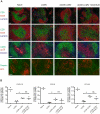Destruction of lymphoid organ architecture and hepatitis caused by CD4+ T cells
- PMID: 21966366
- PMCID: PMC3179489
- DOI: 10.1371/journal.pone.0024772
Destruction of lymphoid organ architecture and hepatitis caused by CD4+ T cells
Abstract
Immune responses have the important function of host defense and protection against pathogens. However, the immune response also causes inflammation and host tissue injury, termed immunopathology. For example, hepatitis B and C virus infection in humans cause immunopathological sequel with destruction of liver cells by the host's own immune response. Similarly, after infection with lymphocytic choriomeningitis virus (LCMV) in mice, the adaptive immune response causes liver cell damage, choriomeningitis and destruction of lymphoid organ architecture. The immunopathological sequel during LCMV infection has been attributed to cytotoxic CD8(+) T cells. However, we now show that during LCMV infection CD4(+) T cells selectively induced the destruction of splenic marginal zone and caused liver cell damage with elevated serum alanin-transferase (ALT) levels. The destruction of the splenic marginal zone by CD4(+) T cells included the reduction of marginal zone B cells, marginal zone macrophages and marginal zone metallophilic macrophages. Functionally, this resulted in an impaired production of neutralizing antibodies against LCMV. Furthermore, CD4(+) T cells reduced B cells with an IgM(high)IgD(low) phenotype (transitional stage 1 and 2, marginal zone B cells), whereas other B cell subtypes such as follicular type 1 and 2 and germinal center/memory B cells were not affected. Adoptive transfer of CD4(+) T cells lacking different important effector cytokines and cytolytic pathways such as IFNγ, TNFα, perforin and Fas-FasL interaction did reveal that these cytolytic pathways are redundant in the induction of immunopathological sequel in spleen. In conclusion, our results define an important role of CD4(+) T cells in the induction of immunopathology in liver and spleen. This includes the CD4(+) T cell mediated destruction of the splenic marginal zone with consecutively impaired protective neutralizing antibody responses.
Conflict of interest statement
Figures







Similar articles
-
Acute and chronic B cell depletion disrupts CD4+ and CD8+ T cell homeostasis and expansion during acute viral infection in mice.J Immunol. 2014 Jul 15;193(2):746-56. doi: 10.4049/jimmunol.1302848. Epub 2014 Jun 13. J Immunol. 2014. PMID: 24928986 Free PMC article.
-
A critical role for neutralizing-antibody-producing B cells, CD4(+) T cells, and interferons in persistent and acute infections of mice with lymphocytic choriomeningitis virus: implications for adoptive immunotherapy of virus carriers.Proc Natl Acad Sci U S A. 1997 Jun 24;94(13):6874-9. doi: 10.1073/pnas.94.13.6874. Proc Natl Acad Sci U S A. 1997. PMID: 9192659 Free PMC article.
-
Targeted deletion of FGL2 leads to increased early viral replication and enhanced adaptive immunity in a murine model of acute viral hepatitis caused by LCMV WE.PLoS One. 2013 Oct 11;8(10):e72309. doi: 10.1371/journal.pone.0072309. eCollection 2013. PLoS One. 2013. PMID: 24146739 Free PMC article.
-
General and specific immunosuppression caused by antiviral T-cell responses.Immunol Rev. 1999 Apr;168:305-15. doi: 10.1111/j.1600-065x.1999.tb01300.x. Immunol Rev. 1999. PMID: 10399082 Review.
-
OX40 and CD30 signals in CD4(+) T-cell effector and memory function: a distinct role for lymphoid tissue inducer cells in maintaining CD4(+) T-cell memory but not effector function.Immunol Rev. 2011 Nov;244(1):134-48. doi: 10.1111/j.1600-065X.2011.01057.x. Immunol Rev. 2011. PMID: 22017436 Review.
Cited by
-
Fatal Lassa fever in cynomolgus monkeys is associated with systemic viral dissemination and inflammation.PLoS Pathog. 2024 Dec 9;20(12):e1012768. doi: 10.1371/journal.ppat.1012768. eCollection 2024 Dec. PLoS Pathog. 2024. PMID: 39652618 Free PMC article.
-
The Janus Face of Follicular T Helper Cells in Chronic Viral Infections.Front Immunol. 2018 May 25;9:1162. doi: 10.3389/fimmu.2018.01162. eCollection 2018. Front Immunol. 2018. PMID: 29887868 Free PMC article. Review.
-
Regulatory T cells and Th17 cells in viral infections: implications for multiple sclerosis and myocarditis.Future Virol. 2012 Jun;7(6):593-608. doi: 10.2217/fvl.12.44. Future Virol. 2012. PMID: 23024699 Free PMC article.
-
Chronic Brucella Infection Induces Selective and Persistent Interferon Gamma-Dependent Alterations of Marginal Zone Macrophages in the Spleen.Infect Immun. 2017 Oct 18;85(11):e00115-17. doi: 10.1128/IAI.00115-17. Print 2017 Nov. Infect Immun. 2017. PMID: 28808159 Free PMC article.
-
NH36 and F3 Antigen-Primed Dendritic Cells Show Preserved Migrating Capabilities and CCR7 Expression and F3 Is Effective in Immunotherapy of Visceral Leishmaniasis.Front Immunol. 2018 May 7;9:967. doi: 10.3389/fimmu.2018.00967. eCollection 2018. Front Immunol. 2018. PMID: 29867949 Free PMC article.
References
-
- Zinkernagel RM, Haenseler E, Leist T, Cerny A, Hengartner H, et al. T cell-mediated hepatitis in mice infected with lymphocytic choriomeningitis virus. Liver cell destruction by H-2 class I-restricted virus-specific cytotoxic T cells as a physiological correlate of the 51Cr-release assay? J Exp Med. 1986;164:1075–1092. - PMC - PubMed
-
- Mebius RE, Kraal G. Structure and function of the spleen. Nat Rev Immunol. 2005;5:606–616. - PubMed
-
- Matter MS, Ochsenbein AF. Natural antibodies target virus-antibody complexes to organized lymphoid tissue. Autoimmun Rev. 2008;7:480–486. - PubMed
Publication types
MeSH terms
Substances
LinkOut - more resources
Full Text Sources
Research Materials
Miscellaneous

